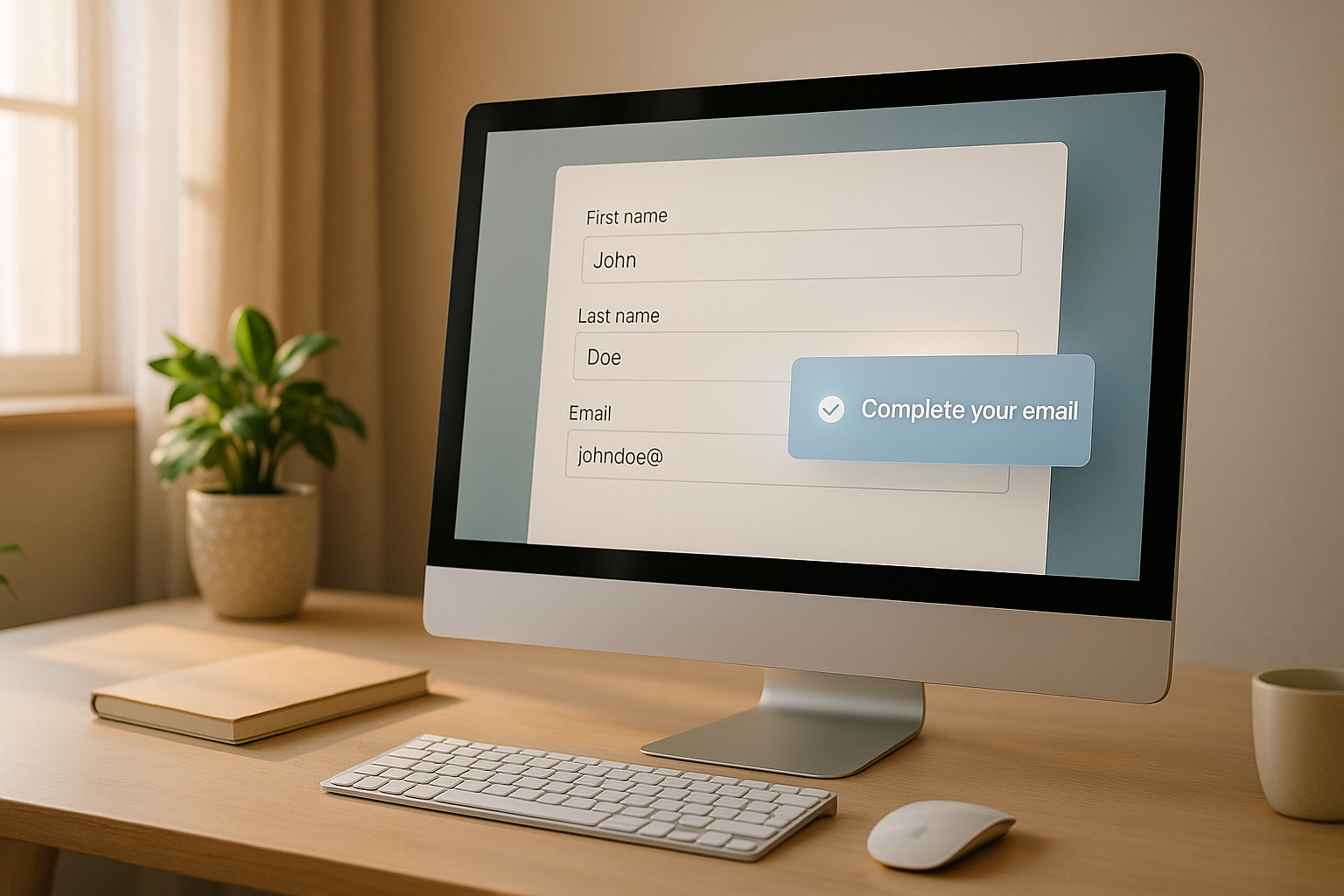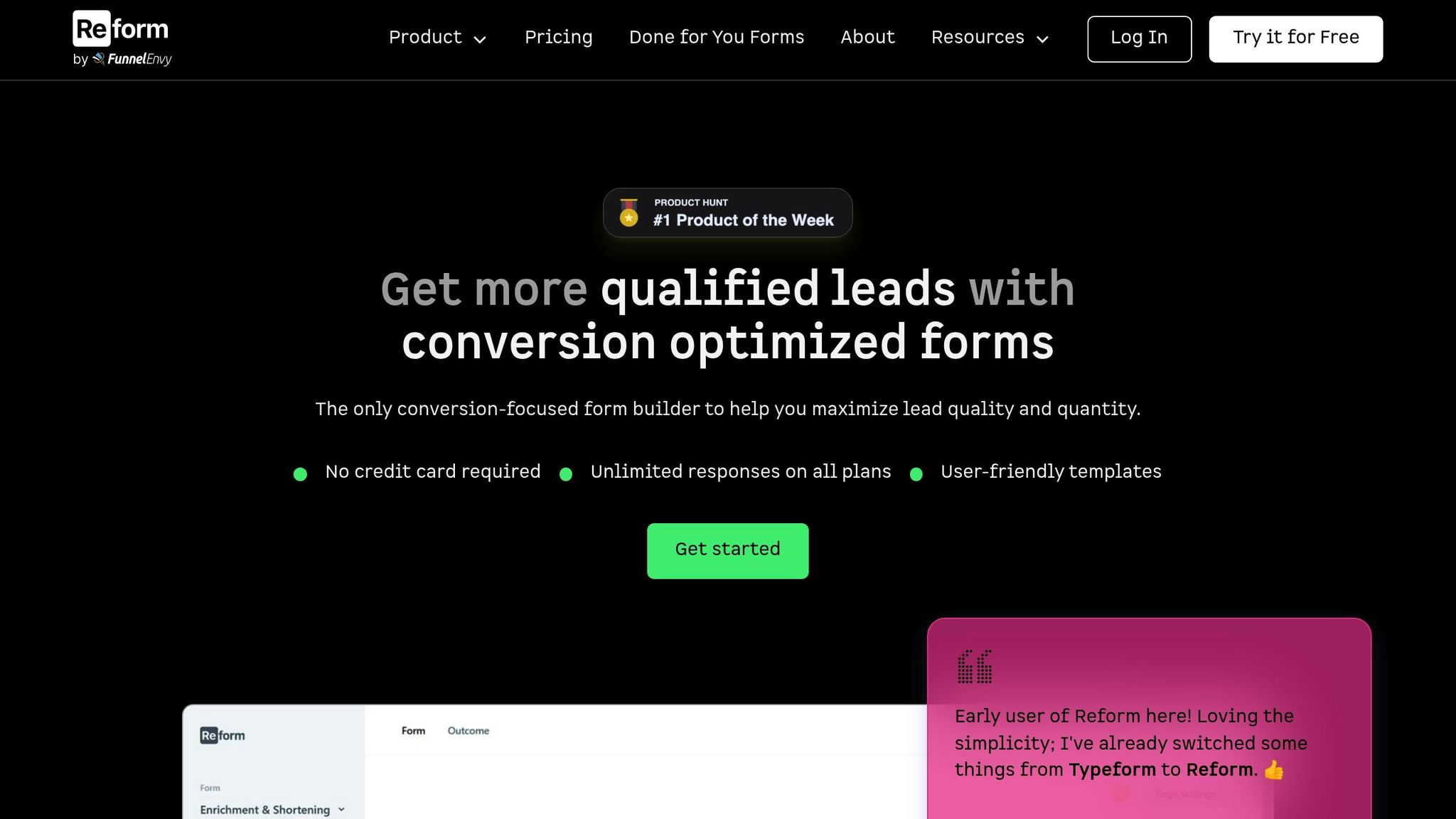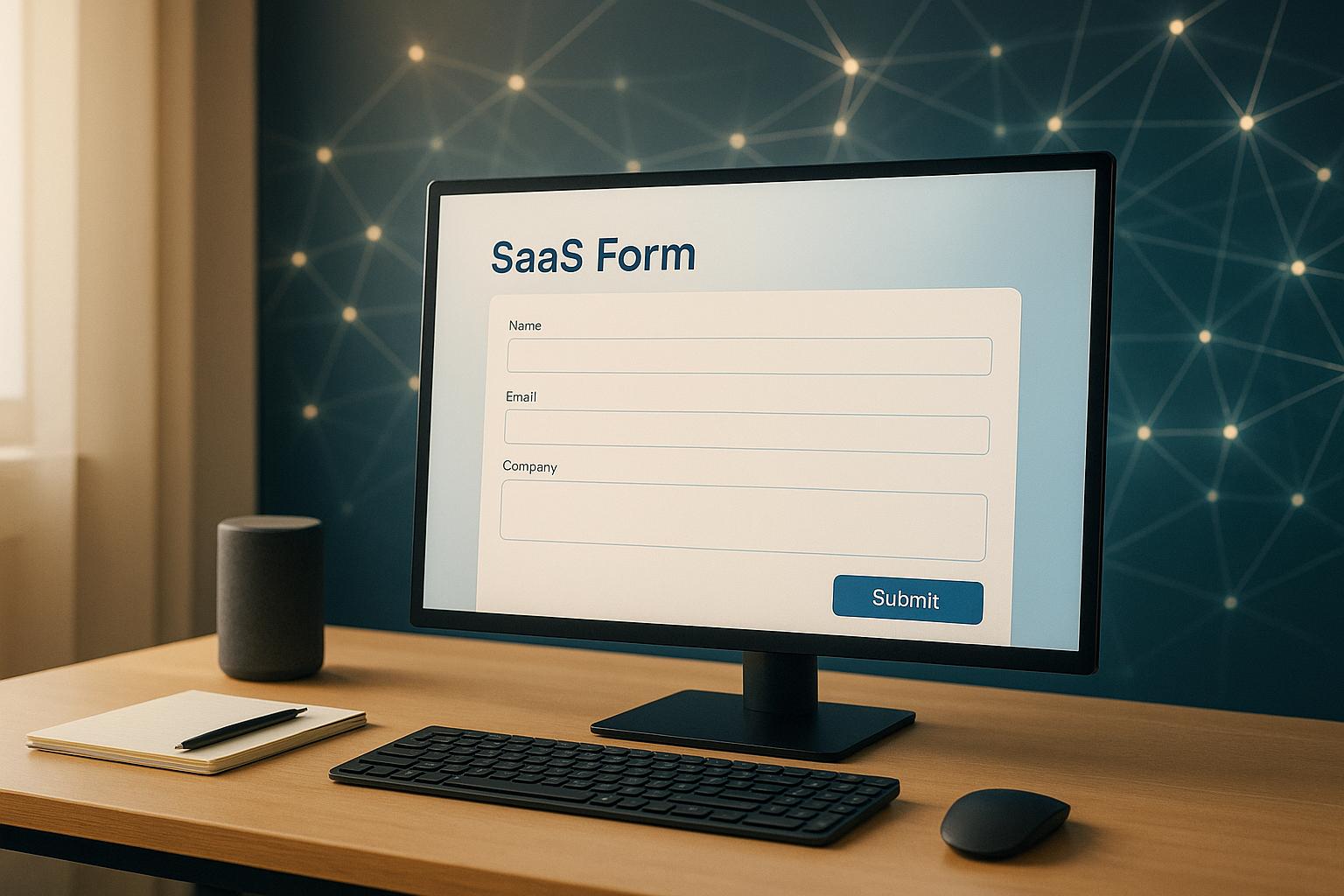How Behavioral Triggers Reduce Form Abandonment

Behavioral triggers can help you recover up to 15% of abandoned forms by responding to user actions in real time. Here’s how they work:
-
Common Causes of Form Abandonment:
- Form Length - Long forms drive users away. Cutting fields by 50% can boost conversions by 120%.
- Privacy Concerns - 81% of users quit due to data security fears. Use trust badges to reassure them.
- Technical Issues - 75% leave forms that don’t work well on their devices. Device-specific help can fix this.
- Unclear Value - If users don’t see the benefit, they won’t complete the form. Highlight the value upfront.
-
Behavioral Trigger Tools:
- Exit-Intent Detection - Tracks mouse movements, inactivity, or tab switching to detect when users are about to leave.
- Timed Reminders - Nudges users to stay engaged with progress indicators and friendly messages.
- Post-Abandonment Follow-ups - Send emails or SMS within 1 hour of abandonment to recover lost leads. For example, SMS has a 98% open rate.
- Quick Tip - Combine these strategies with automated tools like Reform to save progress, personalize follow-ups, and recover leads across email, SMS, and ads.
Use these tactics to reduce form abandonment, recover leads, and improve conversions.
How-to track partial entries & form abandonment in Zoho Forms
Exit-Intent Detection and Response
Exit-intent detection is all about identifying when users are about to leave a webpage without completing a form. By monitoring user behavior, it enables timely interventions to re-engage visitors before they abandon the page. Let’s break down how this works and the strategies that make it effective.
Exit-Intent Detection Methods
Exit-intent technology relies on tracking specific user behaviors that signal an impending departure. Here are some of the most common methods:
| Detection Method | Trigger Signals |
|---|---|
| Mouse Tracking | Sudden upward movement or cursor hovering near browser controls |
| Viewport Monitoring | Scroll position changes or tab switching |
| Inactivity Detection | No interaction with the form for 30–60 seconds |
| Browser Events | Pressing the ESC key or clicking the back button |
Setting the right thresholds for these signals is essential. If thresholds are too sensitive, they might flag false positives, while overly lenient settings could miss genuine exit attempts. Studies suggest that fine-tuned exit-intent systems can identify abandonment patterns with up to 85% accuracy.
Effective Exit-Intent Messages
Once an exit attempt is detected, the next step is delivering a message that persuades users to stay. Tailoring these messages to the specific form type can significantly improve conversion rates - by as much as 60%. Here are some examples:
| Form Type | Effective Message Example |
|---|---|
| Free Trial Sign-up | "Start with 7 days free – no credit card needed." |
| Lead Generation | "Download our buyer's guide while we save your progress." |
| Event Registration | "Tickets are 70% sold out – we'll hold your spot for 15 minutes." |
These messages work best when paired with features like progress-saving. Allowing users to pick up where they left off reduces friction and makes it easier for them to complete the form later.
For even better results, consider combining exit-intent prompts with follow-up channels, such as emails or SMS messages. This multi-channel strategy helps recover leads by keeping the conversation going after the user has left the page.
Some advanced systems take it a step further by using machine learning to refine their approach. These systems analyze user interaction patterns in real-time, adjusting their sensitivity and timing to maximize engagement without disrupting the user experience. When combined with progress-saving features, these tools create a seamless way to keep users moving toward form completion.
Timed Reminders for Form Completion
Timed reminders are a great way to nudge users toward completing forms. These notifications are strategically timed to keep users engaged and reduce the chances of them abandoning the process. They work hand-in-hand with broader behavioral strategies to improve overall completion rates.
On-Form Reminder Messages
The effectiveness of on-form reminders depends on how they’re timed and presented, which varies based on the form's length and complexity:
| Form Length | Initial Trigger | Follow-up Timing | Maximum Reminders |
|---|---|---|---|
| Short (1–5 fields) | 15–20 seconds | Only after re-engagement | 1 per section |
| Medium (6–15 fields) | 25–30 seconds | 15–20 seconds | 2 per section |
| Long (15+ fields) | 30–45 seconds | Section-based | 2–3 per section |
Including progress indicators that show how much of the form is completed can reduce abandonment rates by up to 28%. Features like smart field validation and inactivity triggers also play a key role. For example, if a user is inactive for 20–30 seconds, a subtle animation or a friendly message like, "Still there? Just 2 more questions to go!" can help re-engage them. These on-form cues not only encourage users to keep going but also set the stage for any necessary follow-ups after abandonment.
Post-Abandonment Follow-ups
Recovering abandoned forms requires a carefully planned multi-channel approach. Here's how you can structure it:
-
First Hour Response
Sending an email within the first 60 minutes can recover 25–40% of abandoned forms. Keep the subject line direct, such as "Did you forget something?" to grab attention quickly. -
24-Hour Mark
A second email at the 24-hour mark reinforces the form’s importance and addresses potential concerns, leading to an additional recovery rate of 15–20%. Including any previously entered data and a clear link to pick up where they left off can make a big difference. -
48-Hour Final Notice
A final email at the 48-hour mark creates a sense of urgency, typically recovering another 5–10% of abandoned forms.
SMS follow-ups are also incredibly effective, with open rates as high as 98%. A well-timed SMS, sent 2–4 hours after abandonment, can provide a quick and easy way for users to complete their forms. For instance, a message like, "Hi [Name], your [form type] is 80% complete! Finish in 2 minutes to secure your [benefit]" can significantly boost recovery rates. This combination of email and SMS ensures you’re reaching users through multiple channels, increasing the chances of completion.
sbb-itb-5f36581
Cross-Platform Lead Recovery
Building on earlier strategies, cross-platform lead recovery brings together multiple channels - like email, retargeting ads, and SMS - to re-engage users who abandon forms. By coordinating efforts across these platforms, businesses can significantly improve their ability to recover lost leads.
Using Partial Forms to Build Audiences
When someone starts filling out a form but doesn’t finish, that partial data becomes a valuable tool for follow-up campaigns. This information can help create custom audiences for retargeting. Tailoring messages based on where users left off - for instance, letting them know they were just a step away from completing - can make a big difference. In fact, personalized retargeting messages have been shown to increase recovery rates by up to 30%.
Leveraging CRM Systems for Lead Recovery
Connecting form data to a CRM system allows for automated, highly targeted recovery workflows. Partial form submissions can trigger campaigns designed to address specific abandonment behaviors.
Modern CRM tools make this process even more effective with features like:
- Quick Follow-Up - Capture partial submissions and send a recovery message within 60 minutes.
-
Multi-Channel Campaigns - Coordinate recovery efforts across platforms, such as:
- Email sequences that gradually increase urgency
- SMS notifications, which boast open rates as high as 98%
- Retargeting ads on social media
- Browser push notifications
- Progress Monitoring - Track user activity to refine timing and messaging for follow-ups.
Studies show that sending the first recovery email within an hour of abandonment, followed by reminders at 24 and 48 hours, can significantly improve lead recovery rates. By combining speed, personalization, and multiple touchpoints, businesses can turn abandoned forms into valuable conversions.
Reform's Behavioral Trigger Tools

Reform takes user engagement a step further with its behavioral trigger tools, designed to capture partial form submissions and re-engage users in real time.
Exit Detection and Progress Saving
Reform tracks specific behaviors that signal a user might abandon a form, such as:
- Moving the mouse toward the browser's close button
- Quick cursor movement away from the form area
- Long periods of inactivity
When these behaviors are detected, Reform saves any partial data entered, ensuring progress isn’t lost even if the session is interrupted. On top of that, Reform offers customizable workflows to help recover and re-engage users seamlessly.
Ready-Made Recovery Workflows
Reform simplifies user recovery with pre-built workflows that integrate directly with your marketing tools. These workflows can be tailored to reflect your brand’s tone and style. Recovery options span multiple channels, including:
| Channel | Timing | Purpose |
|---|---|---|
| Within 1 hour | Sends a personalized link to encourage users to complete the form | |
| SMS | 24 hours | High-priority reminder with a 98% open rate |
These workflows automatically generate personalized links, making it easy for users to pick up where they left off. Features include:
- Dynamic fields that pull in saved user data
- Branded messaging to maintain consistency
- Custom timing sequences based on user activity
- Conditional logic to adapt workflows for different forms or user segments
With an integrated analytics dashboard, businesses can monitor campaign performance in real time. This allows for fine-tuning of trigger timing and messaging while minimizing the risk of over-communicating with users.
Conclusion: Implementing Effective Triggers
To successfully implement behavioral triggers, you need a well-thought-out strategy that blends timing, personalization, and multi-channel outreach. Start with the triggers that address your most common abandonment patterns, and gradually expand into a more comprehensive recovery system.
A good first step is setting up automated email follow-ups. Aim to send the first email within an hour of abandonment, then follow up with a second reminder within 24 hours. Acting quickly keeps the user's intent fresh and increases the likelihood of re-engagement.
Take it a step further by personalizing recovery messages based on data from partial form submissions. Instead of generic reminders, tailor your outreach to where users dropped off. For instance, if someone abandons at the pricing stage, follow up with details about payment plans or the value your service offers.
Reform’s behavioral trigger tools make this process easier by detecting exit intent and saving user progress automatically. These tools integrate smoothly with your existing marketing stack, offering features like:
- Real-time tracking of abandonment behaviors
- Automatic saving of partial form data
- Personalized recovery messaging across multiple channels
- Detailed analytics to monitor campaign performance
While persistence is important, it’s equally crucial to respect user boundaries. Limit recovery efforts to 2–3 touchpoints within a 48-hour window to avoid overwhelming your audience. This balanced approach helps maintain engagement without pushing users away.
FAQs
How can behavioral triggers like exit-intent detection help prevent form abandonment?
Behavioral triggers, like exit-intent detection, are a smart way to tackle form abandonment by engaging users just before they leave. For instance, when someone seems ready to abandon a form, an exit-intent pop-up can step in with a friendly reminder, a special incentive, or even a quick reassurance about the process to keep them on track.
Another effective approach? Retargeting emails. These emails reach out to users who left a form incomplete, nudging them with reminders about their progress and inviting them to finish what they started. By addressing hesitation or distractions head-on, these strategies can help recover lost opportunities and boost conversion rates.
What are the best strategies for timing and crafting messages in post-abandonment follow-ups?
To make post-abandonment follow-ups more effective, timing and messaging are everything. Start by sending the first follow-up within 1–2 hours of the form being abandoned. This keeps your message fresh in the user's mind and increases the likelihood of re-engagement. A second follow-up, sent 24–48 hours later, can serve as a polite reminder without feeling intrusive.
When it comes to the message itself, keep it personal and to the point. If possible, address the user by name, emphasize the benefits of completing the form, and include a clear and direct call-to-action (CTA) that takes them back to where they left off. Behavioral cues can also make a big difference - mention specific advantages they’ll gain or offer help if they ran into any issues. For instance, you might say, “Hi [Name], we noticed you began filling out our form. Let us know if there’s anything we can do to assist you in completing it!”
By pairing well-timed follow-ups with messages that feel thoughtful and relevant, you can greatly increase the chances of turning abandoned forms into completed ones.
How can businesses use behavioral triggers to reduce form abandonment and improve lead recovery?
Behavioral triggers like time-based nudges and retargeting emails can play a big role in cutting down form abandonment and pulling back lost leads. For instance, a timely pop-up can nudge users to finish a half-completed form, while a follow-up email can reconnect with those who left the form incomplete.
To make these strategies work, start by diving into user behavior on your forms - pinpoint where people tend to drop off - and set up triggers to tackle those problem areas. A platform like Reform can help you design customized, branded forms and combine them with features like email validation and real-time analytics. These tools not only make the process smoother for users but also improve the quality of the leads you collect.
Related posts
Get new content delivered straight to your inbox

The Response
Updates on the Reform platform, insights on optimizing conversion rates, and tips to craft forms that convert.
Drive real results with form optimizations
Tested across hundreds of experiments, our strategies deliver a 215% lift in qualified leads for B2B and SaaS companies.





